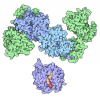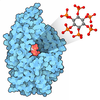[English] 日本語
 Yorodumi
Yorodumi- PDB-8vse: Cryo-EM structure of human CD45 extracellular region in complex w... -
+ Open data
Open data
- Basic information
Basic information
| Entry | Database: PDB / ID: 8vse | |||||||||||||||||||||||||||||||||||||||||||||
|---|---|---|---|---|---|---|---|---|---|---|---|---|---|---|---|---|---|---|---|---|---|---|---|---|---|---|---|---|---|---|---|---|---|---|---|---|---|---|---|---|---|---|---|---|---|---|
| Title | Cryo-EM structure of human CD45 extracellular region in complex with adenoviral protein E3/49K | |||||||||||||||||||||||||||||||||||||||||||||
 Components Components |
| |||||||||||||||||||||||||||||||||||||||||||||
 Keywords Keywords | IMMUNE SYSTEM / Complex / T cell signaling / Viral suppression | |||||||||||||||||||||||||||||||||||||||||||||
| Function / homology |  Function and homology information Function and homology informationplasma membrane raft distribution / positive regulation of antigen receptor-mediated signaling pathway / positive regulation of hematopoietic stem cell migration / negative regulation of cytokine-mediated signaling pathway / negative regulation of interleukin-4-mediated signaling pathway / alpha-beta T cell proliferation / negative regulation of cell adhesion involved in substrate-bound cell migration / positive regulation of Fc receptor mediated stimulatory signaling pathway / membrane microdomain / regulation of T cell receptor signaling pathway ...plasma membrane raft distribution / positive regulation of antigen receptor-mediated signaling pathway / positive regulation of hematopoietic stem cell migration / negative regulation of cytokine-mediated signaling pathway / negative regulation of interleukin-4-mediated signaling pathway / alpha-beta T cell proliferation / negative regulation of cell adhesion involved in substrate-bound cell migration / positive regulation of Fc receptor mediated stimulatory signaling pathway / membrane microdomain / regulation of T cell receptor signaling pathway / regulation of interleukin-8 production / negative regulation of T cell mediated cytotoxicity / negative regulation of microglial cell activation / Other semaphorin interactions / positive regulation of humoral immune response mediated by circulating immunoglobulin / cell cycle phase transition / DN2 thymocyte differentiation / transmembrane receptor protein tyrosine phosphatase activity / natural killer cell differentiation / stem cell development / positive regulation of alpha-beta T cell proliferation / bleb / positive regulation of isotype switching to IgG isotypes / gamma-delta T cell differentiation / positive regulation of gamma-delta T cell differentiation / negative thymic T cell selection / negative regulation of receptor signaling pathway via JAK-STAT / regulation of phagocytosis / positive thymic T cell selection / response to aldosterone / heparan sulfate proteoglycan binding / protein tyrosine kinase inhibitor activity / dephosphorylation / bone marrow development / positive regulation of extrinsic apoptotic signaling pathway / ankyrin binding / heterotypic cell-cell adhesion / positive regulation of immunoglobulin production / negative regulation of interleukin-2 production / leukocyte cell-cell adhesion / spectrin binding / positive regulation of stem cell proliferation / Phosphorylation of CD3 and TCR zeta chains / positive regulation of protein kinase activity / B cell proliferation / T cell differentiation / hematopoietic progenitor cell differentiation / protein dephosphorylation / negative regulation of protein kinase activity / extrinsic apoptotic signaling pathway / positive regulation of B cell proliferation / release of sequestered calcium ion into cytosol / positive regulation of T cell proliferation / protein-tyrosine-phosphatase / positive regulation of interleukin-2 production / positive regulation of calcium-mediated signaling / protein tyrosine phosphatase activity / positive regulation of phagocytosis / secretory granule membrane / T cell activation / B cell differentiation / response to gamma radiation / B cell receptor signaling pathway / negative regulation of ERK1 and ERK2 cascade / positive regulation of T cell mediated cytotoxicity / cytoplasmic side of plasma membrane / positive regulation of tumor necrosis factor production / T cell receptor signaling pathway / MAPK cascade / heparin binding / regulation of gene expression / defense response to virus / cell surface receptor signaling pathway / positive regulation of ERK1 and ERK2 cascade / regulation of cell cycle / positive regulation of MAPK cascade / membrane raft / signaling receptor binding / external side of plasma membrane / focal adhesion / synapse / Neutrophil degranulation / protein kinase binding / cell surface / negative regulation of transcription by RNA polymerase II / signal transduction / extracellular exosome / membrane / plasma membrane Similarity search - Function | |||||||||||||||||||||||||||||||||||||||||||||
| Biological species |  Homo sapiens (human) Homo sapiens (human) Human adenovirus 19a Human adenovirus 19a | |||||||||||||||||||||||||||||||||||||||||||||
| Method | ELECTRON MICROSCOPY / single particle reconstruction / cryo EM / Resolution: 3.8 Å | |||||||||||||||||||||||||||||||||||||||||||||
 Authors Authors | Borowska, M.T. / Caveney, N.A. / Jude, K.M. / Garcia, K.C. | |||||||||||||||||||||||||||||||||||||||||||||
| Funding support |  United States, 3items United States, 3items
| |||||||||||||||||||||||||||||||||||||||||||||
 Citation Citation |  Journal: Sci Immunol / Year: 2024 Journal: Sci Immunol / Year: 2024Title: Orientation-dependent CD45 inhibition with viral and engineered ligands. Authors: Marta T Borowska / Liu D Liu / Nathanael A Caveney / Kevin M Jude / Won-Ju Kim / Takeya Masubuchi / Enfu Hui / Robbie G Majzner / K Christopher Garcia /  Abstract: CD45 is a cell surface phosphatase that shapes the T cell receptor signaling threshold but does not have a known ligand. A family of adenovirus proteins, including E3/49K, exploits CD45 to evade ...CD45 is a cell surface phosphatase that shapes the T cell receptor signaling threshold but does not have a known ligand. A family of adenovirus proteins, including E3/49K, exploits CD45 to evade immunity by binding to the extracellular domain of CD45, resulting in the suppression of T cell signaling. We determined the cryo-EM structure of this complex and found that the E3/49K protein is composed of three immunoglobulin domains assembled as "beads on a string" that compel CD45 into a closely abutted dimer by cross-linking the CD45 D3 domain, leading to steric inhibition of its intracellular phosphatase activity. Inspired by the E3/49K mechanism, we engineered CD45 surrogate ligands that can fine-tune T cell activation by dimerizing CD45 into different orientations and proximities. The adenovirus E3/49K protein has taught us that, despite a lack of a known ligand, CD45 activity can be modulated by extracellular dimerizing ligands that perturb its phosphatase activity and alter T cell responses. | |||||||||||||||||||||||||||||||||||||||||||||
| History |
|
- Structure visualization
Structure visualization
| Structure viewer | Molecule:  Molmil Molmil Jmol/JSmol Jmol/JSmol |
|---|
- Downloads & links
Downloads & links
- Download
Download
| PDBx/mmCIF format |  8vse.cif.gz 8vse.cif.gz | 199 KB | Display |  PDBx/mmCIF format PDBx/mmCIF format |
|---|---|---|---|---|
| PDB format |  pdb8vse.ent.gz pdb8vse.ent.gz | 153.2 KB | Display |  PDB format PDB format |
| PDBx/mmJSON format |  8vse.json.gz 8vse.json.gz | Tree view |  PDBx/mmJSON format PDBx/mmJSON format | |
| Others |  Other downloads Other downloads |
-Validation report
| Summary document |  8vse_validation.pdf.gz 8vse_validation.pdf.gz | 1.8 MB | Display |  wwPDB validaton report wwPDB validaton report |
|---|---|---|---|---|
| Full document |  8vse_full_validation.pdf.gz 8vse_full_validation.pdf.gz | 1.8 MB | Display | |
| Data in XML |  8vse_validation.xml.gz 8vse_validation.xml.gz | 44.9 KB | Display | |
| Data in CIF |  8vse_validation.cif.gz 8vse_validation.cif.gz | 64.9 KB | Display | |
| Arichive directory |  https://data.pdbj.org/pub/pdb/validation_reports/vs/8vse https://data.pdbj.org/pub/pdb/validation_reports/vs/8vse ftp://data.pdbj.org/pub/pdb/validation_reports/vs/8vse ftp://data.pdbj.org/pub/pdb/validation_reports/vs/8vse | HTTPS FTP |
-Related structure data
| Related structure data |  43497MC M: map data used to model this data C: citing same article ( |
|---|---|
| Similar structure data | Similarity search - Function & homology  F&H Search F&H Search |
- Links
Links
- Assembly
Assembly
| Deposited unit | 
|
|---|---|
| 1 |
|
- Components
Components
| #1: Protein | Mass: 60713.836 Da / Num. of mol.: 2 / Fragment: extracellular domain Source method: isolated from a genetically manipulated source Source: (gene. exp.)  Homo sapiens (human) / Gene: PTPRC, CD45 / Production host: Homo sapiens (human) / Gene: PTPRC, CD45 / Production host:  Homo sapiens (human) / References: UniProt: P08575, protein-tyrosine-phosphatase Homo sapiens (human) / References: UniProt: P08575, protein-tyrosine-phosphatase#2: Protein | | Mass: 39408.938 Da / Num. of mol.: 1 Source method: isolated from a genetically manipulated source Source: (gene. exp.)  Human adenovirus 19a / Gene: 49K, E3 / Production host: Human adenovirus 19a / Gene: 49K, E3 / Production host:  Homo sapiens (human) / References: UniProt: Q67812 Homo sapiens (human) / References: UniProt: Q67812#3: Polysaccharide | 2-acetamido-2-deoxy-beta-D-glucopyranose-(1-4)-2-acetamido-2-deoxy-beta-D-glucopyranose #4: Polysaccharide | beta-D-mannopyranose-(1-4)-2-acetamido-2-deoxy-beta-D-glucopyranose-(1-4)-2-acetamido-2-deoxy-beta- ...beta-D-mannopyranose-(1-4)-2-acetamido-2-deoxy-beta-D-glucopyranose-(1-4)-2-acetamido-2-deoxy-beta-D-glucopyranose | #5: Sugar | ChemComp-NAG / Has ligand of interest | N | Has protein modification | Y | |
|---|
-Experimental details
-Experiment
| Experiment | Method: ELECTRON MICROSCOPY |
|---|---|
| EM experiment | Aggregation state: PARTICLE / 3D reconstruction method: single particle reconstruction |
- Sample preparation
Sample preparation
| Component | Name: Complex of extracellular domain od human CD45 and extracellular domain of adenoviral protein E3/49K Type: COMPLEX / Entity ID: #2 / Source: MULTIPLE SOURCES |
|---|---|
| Molecular weight | Value: 0.164 MDa / Experimental value: NO |
| Source (natural) | Organism:  Homo sapiens (human) Homo sapiens (human) |
| Source (recombinant) | Organism:  Homo sapiens (human) Homo sapiens (human) |
| Buffer solution | pH: 7.4 |
| Specimen | Conc.: 1.8 mg/ml / Embedding applied: NO / Shadowing applied: NO / Staining applied: NO / Vitrification applied: YES |
| Specimen support | Grid type: Quantifoil R1.2/1.3 |
| Vitrification | Instrument: FEI VITROBOT MARK IV / Cryogen name: ETHANE / Humidity: 100 % / Chamber temperature: 277.15 K |
- Electron microscopy imaging
Electron microscopy imaging
| Experimental equipment |  Model: Titan Krios / Image courtesy: FEI Company |
|---|---|
| Microscopy | Model: TFS KRIOS |
| Electron gun | Electron source:  FIELD EMISSION GUN / Accelerating voltage: 300 kV / Illumination mode: FLOOD BEAM FIELD EMISSION GUN / Accelerating voltage: 300 kV / Illumination mode: FLOOD BEAM |
| Electron lens | Mode: OTHER / Nominal defocus max: 2000 nm / Nominal defocus min: 800 nm |
| Image recording | Electron dose: 60 e/Å2 / Film or detector model: GATAN K3 BIOQUANTUM (6k x 4k) |
- Processing
Processing
| EM software |
| ||||||||||||||||||||||||
|---|---|---|---|---|---|---|---|---|---|---|---|---|---|---|---|---|---|---|---|---|---|---|---|---|---|
| CTF correction | Type: PHASE FLIPPING AND AMPLITUDE CORRECTION | ||||||||||||||||||||||||
| Particle selection | Num. of particles selected: 5306556 | ||||||||||||||||||||||||
| 3D reconstruction | Resolution: 3.8 Å / Resolution method: FSC 0.143 CUT-OFF / Num. of particles: 377081 / Symmetry type: POINT | ||||||||||||||||||||||||
| Atomic model building | Protocol: FLEXIBLE FIT / Space: REAL | ||||||||||||||||||||||||
| Refine LS restraints |
|
 Movie
Movie Controller
Controller


 PDBj
PDBj













